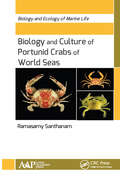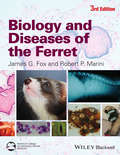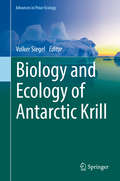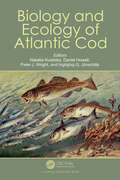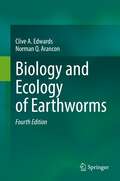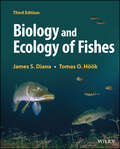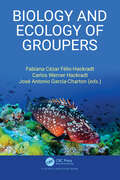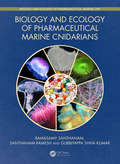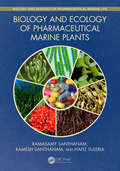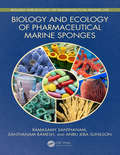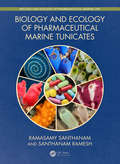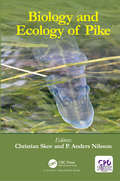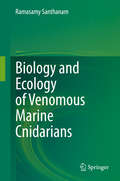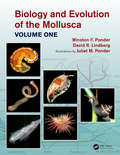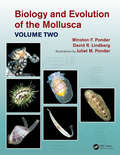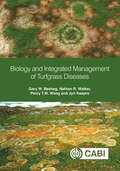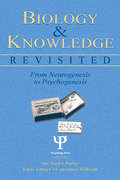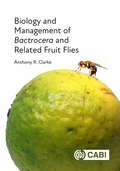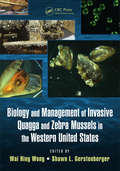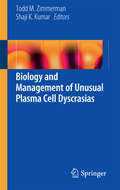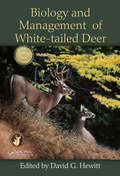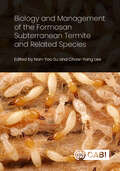- Table View
- List View
Biology and Culture of Portunid Crabs of World Seas (Biology and Ecology of Marine Life)
by Ramasamy SanthanamBiology and Culture of Portunid Crabs of World Seas provides an abundance of valuable first-hand information about the diversity, biology, ecology culture of the portunid crabs of the word seas. Marine crabs play an important role directly or indirectly in the livelihood of millions of people around the world. They have been reported to make up about 20% of all marine crustaceans caught, farmed, and consumed worldwide. Among these marine crabs, portunid crabs or swimming crabs of the family Portunidae (Class: Crustacea; Order: Decapoda; Infraorder: Brachyura) assume greater significance in the marine industry owing to their delicate meat with nutritional qualities. Although, several species of portunid crabs are edible and commercially important, only a few species of Scylla and Portunus have been widely cultivated. This is largely due to the lack of information on the biology of portunid crabs. Keeping this in view, this new volume presents the biology and aquaculture of marine portunid crabs. This volume will be of great use for researchers and students of disciplines such as fisheries science, marine biology, aquatic biology and fisheries and zoology and will also serve as a standard reference for college, university, and research libraries around the world.
Biology and Diseases of the Ferret
by Robert P. Marini James G. FoxBiology and Diseases of the Ferret, Third Edition has been thoroughly revised and updated to provide a current, comprehensive reference on the ferret. Encyclopedic in scope, it is the only book to focus on the characteristics that make the ferret an important research animal, with detailed information on conditions, procedures, and treatments. Offering basic information on biology, husbandry, clinical medicine, and surgery, as well as unique information on the use of ferrets in biomedical research, Biology and Diseases of the Ferret is an essential resource for investigators using ferrets in the laboratory and for companion animal and comparative medicine veterinarians.The Third Edition adds ten completely new chapters, covering regulatory considerations, black-footed ferret recovery, diseases of the cardiovascular system, viral respiratory disease research, morbillivirus research, genetic engineering, hearing and auditory function, vision and neuroplasticity research, nausea and vomiting research, and lung carcinogenesis research. Additionally, the anesthesia, surgery, and biomethodology chapter has been subdivided into three and thoroughly expanded. The book also highlights the ferret genome project, along with the emerging technology of genetically engineered ferrets, which is of particular importance to the future of the ferret as an animal model in research and will allow the investigation of diseases and their genetic basis in a small, easily maintained, non-rodent species.
Biology and Ecology of Antarctic Krill (Advances in Polar Ecology #1)
by Volker SiegelThis book gives a unique insight into the current knowledge of krill population dynamics including distribution, biomass, production, recruitment, growth and mortality rates. Detailed analysis is provided on food and feeding, reproduction and krill behaviour. The volume provides an overview on the aspects of natural challenges to the species, which involve predation, parasites and the commercial exploitation of the resource and its management. A chapter on genetics shows the results of population subdivision and summarizes recent work on sequencing transcriptomes for studying gene function as part of the physiology of live krill. The focus of Chapter 4 is on physiological functions such as biochemical composition, metabolic activity and growth change with ontogeny and season; and will demonstrate which environmental factors are the main drivers for variability. Further discussed in this chapter are the bottle necks which occur in the annual life cycle of krill, and the mechanisms krill have adapted to cope with severe environmental condition.
Biology and Ecology of Atlantic Cod
by Peter J. Wright Daniel Howell Nataliia Kulatska Ingibjörg G. JónsdóttirAtlantic cod is an important fish species in human history and continues to be a major influence on North Atlantic fisheries management, as stock collapses and recoveries impact coastal communities and shelf sea food webs. This book provides an overview of Atlantic cod biology and ecology, focussing on regional differences in life-history and stock dynamics that affect productivity and the challenges faced by management. By comparing the success of management approaches and the local influence of changing climate and food webs, the book highlights the different pressures facing stocks and identifies knowledge gaps across the species’ range.
Biology and Ecology of Earthworms
by Clive A. Edwards Norman Q. AranconBiology and Ecology of Earthworms is established as a key valuable text for students of agriculture, soil science, and soil invertebrate zoology and ecology. This is the 4th Edition of the popular textbook which reviews all aspects of earthworm biology and ecology. The book has been fully revised and updated throughout. Particular changes include: new treatments of earthworm taxonomy, diversity, migration and geographical distribution; interactions between earthworms and other soil organisms, especially microorganisms and soil-borne pests and diseases; as well as the importance of earthworms in organic waste management.
Biology and Ecology of Fishes
by James S. Diana Tomas O. HöökBiology and Ecology of Fishes Immerse yourself in the world of fish ecology with the newest edition of this essential introduction The study of fish ecology has traditionally proceeded along two tracks: the first is more basic, concerned with the anatomy, physiology and theoretical ecology of fish, and the second is more practical, concerning itself with fish populations, management, and habitats. Many fish researchers have come to view this distinction as artificial, and to develop a new study of fish that combines both tracks in a single holistic approach. It has never been more critical for introductory textbooks to represent this combined study in order to prepare the next generation of fish biologists and fishery scientists. Biology and Ecology of Fishes meets this need with a textbook that incorporates both biology and population management. Beginning with a general introduction to aquatic life and ecosystems, this book covers anatomical, environmental, and ethological topics to give a thoroughly rounded view of its subject, promising to serve as the fundamental introduction to multidisciplinary fish studies. Readers of the third edition of Biology and Ecology of Fishes will also find: Detailed coverage of subjects including growth and bioenergetics, feeding and predation, mortality and recruitment and more Increased attention to stressors of fish populations and communities New and revised chapters that introduce quantitative methods and present emerging issues facing fish populations and communities Biology and Ecology of Fishes is a useful overview for advanced undergraduate and graduate students studying fish ecology or fishery biology, as well as a reference for researchers and professionals in fish ecology, fish population management, and related fields.
Biology and Ecology of Groupers
by Fabiana Cézar Félix-HackradtGroupers are fascinating charismatic fishes commonly found in reef habitats around the world that sustain a global multimillionaire fishery. They are an important top predator species and therefore of paramount ecological importance for reef systems' resilience. The book, Biology and Ecology of Groupers is an up-to-date review of the main bio-ecological topics involving worldwide groupers species oriented to the academic community and managers. It covers aspects of classification and phylogenetic relationships, geographical distribution, and life history related characteristics (Section I), including the major threats of groupers populations, case studies of successful management and comments about the future of groupers in our changing world (Section II).
Biology and Ecology of Pharmaceutical Marine Cnidarians (Biology and Ecology of Marine Life)
by Ramasamy Santhanam Santhanam Ramesh Gubbiyappa Shiva KumarThe first comprehensive book on the biology and ecology of pharmaceutical cnidarians, answering a need for more knowledge about the identification, biology, natural products and bioactivities of these living resources. Contributed by scientists of both marine biology and pharmacy disciplines. Identifies the correct marine species, shows the ecological parameters of that species, and explores its biological values with particular attention to primary and secondary metabolites or bioactive constituents. A useful supplementary text on Marine Biology and Pharmacology courses. Nearly 200 illustrations are produced in full color, providing a high-quality reference. This book provides the taxonomy, common name, global distribution, habitat, diagnostic features, and pharmaceutical compounds (along with their activities) of 200 species of marine cnidarians along with nearly 200 detailed illustrations in glorious color. The phylum Cnidaria (formerly Coelenterata) is a large, diverse, and ecologically important group of marine invertebrates which make up 40 percent of the biomass of the oceans. Marine invertebrates are the richest source of marine natural products with potential applications in the pharmaceutical and medical sectors, and it has been reported that over 3000 bioactive compounds have been described from this phylum alone, mostly in the last decade.
Biology and Ecology of Pharmaceutical Marine Life: Echinoderms (Biology and Ecology of Marine Life)
by Ramasamy Santhanam Santhanam Ramesh Sheba Rani Nakka DavidThe first comprehensive book on the biology and ecology of pharmaceutical echinoderms. Contributed by scientists of both marine biology and pharmacy disciplines. All reported echinoderm species producing secondary metabolites are dealt with. Previously known only as nutritional invertebrates, the contribution of the echinoderms as sources of secondary metabolites for therapeutic compounds is a topic ripe for exploration. All 200+ images are produced in full color. This book provides the taxonomy, common name, global distribution, habitat, diagnostic features and pharmaceutical compounds (along with their activities) of 150 species of ecinoderms along with over 200 detailed illustrations in glorious color. Among the biota of marine habitats, the echinoderms, which include sea stars (starfish), brittle stars and basket stars, sea urchins and sand dollars, sea cucumbers, and sea lilies or feather stars, are known for their importance as promising sources of bioactive compounds for development of pharmaceuticals. Their potential therapeutic applications have been growing rapidly in the treatment of many diseases.
Biology and Ecology of Pharmaceutical Marine Mollusks (Biology and Ecology of Marine Life)
by Ramasamy Santhanam Santhanam Ramesh Manavalan GobinathKey features: Serves as a standard reference for researchers, teachers and students of various disciplines such as Fisheries Science, Marine Biology, Life Sciences, Biotechnology, Natural Products, Biochemistry, and Pharmacy, their libraries, and as a valuable guide for pharmaceutical companies involved in the development of new drugs Presents the taxonomy, common name, global distribution, and habitat of 275 species of marine molluscs Provides the diagnostic features and pharmaceutical compounds (along with their chemical structure and activities) of 275 species of marine molluscs Includes more than 500 detailed illustrations Covers bivalves, gastropods, and cephalopods Biology and Ecology of Pharmaceutical Marine Molluscs is the first comprehensive book of its kind written by scientists from both the Marine Biology and Pharmacy disciplines to fill the long-felt need for a marine natural products book devoted exclusively to molluscs. The taxonomy, common name, global distribution, habitat, diagnostic features and pharmaceutical compounds (along with their activities) of 275 species of marine molluscs are given in this comprehensive work, with accompanying illustrations. Bioactive substances isolated from marine invertebrates such as poriferans, coelenterates, molluscs, echinoderms, bryozoans and tunicates have been reported to possess antiviral, antimicrobial, antiprotozoal, antifungal, antihelmintic and anticancer activities. Among the marine invertebrates, marine molluscs have significant commercial applications; for instance, as a source of food, ornaments and production of lime. A few species of molluscs have also been reported to act as scavengers in cleaning the environment and pollution indicators. Recently, many molluscan species have been identified as a potential source of secondary metabolites, having a wide range of pharmaceutical applications. This should be a standard reference for students, researchers and teachers of disciplines such as Pharmacy, Fisheries Science, Marine Biology, Life Sciences, Biotechnology and Biochemistry, as well as a valuable guide for pharmaceutical companies involved in the development of new drugs from marine molluscs.
Biology and Ecology of Pharmaceutical Marine Plants (Biology and Ecology of Marine Life)
by Ramasamy Santhanam Santhanam Ramesh Hafiz Ansar SuleriaKey features: A standard reference for researchers, teachers and students of Marine Biology, Fisheries Science, Botany/Plant Science, Biotechnology, Natural Products, and Pharmacy, their libraries A valuable guide for pharmaceutical companies involved in the development of new drugs from marine plants Presents the taxonomy, common name, global distribution, and habitat of 400 species of marine plants Provides the diagnostic features and pharmaceutical compounds (along with their chemical structure and activities) of 400 species of marine plants Includes more than 600 detailed illustrations Covers blue-green algae, green algae, brown algae, and red algae Marine plants such as algae (blue-green algae and seaweeds), seagrasses, mangrove plants, salt-tolerant or salt-loving plants (halophytes) and coastal sand dune plants are known to generate approximately 70% of oxygen on earth, and help regulate oxygen in the atmosphere. These plants are potential sources of nutrients and are also considered valuable for the development of new drugs owing to their unique bioactive compounds. This book provides the taxonomy, common name, global distribution, habitat, diagnostic features and pharmaceutical compounds (along with their activities) of 400 species of marine plants, accompanied by high quality illustrations. Biology and Ecology of Pharmaceutical Marine Plants is the first comprehensive book of its kind written by scientists from both the Marine Biology and Pharmacy disciplines to fill the long-felt need for a marine natural products book devoted exclusively to plants. It should be a standard reference for students, researchers and teachers of disciplines such as Pharmacy, Fisheries Science, Marine Biology, Life Sciences, Biotechnology and Biochemistry, as well as a valuable guide for pharmaceutical companies involved in the development of new drugs from marine plants.
Biology and Ecology of Pharmaceutical Marine Sponges (Biology and Ecology of Marine Life)
by Ramasamy Santhanam Santhanam Ramesh Anbu SunilsonKey features: Serves as a standard reference for researchers, teachers and students of various disciplines such as Fisheries Science, Marine Biology, Life Sciences, Biotechnology, Natural Products, and Pharmacy, their libraries, and as a valuable guide for pharmaceutical companies involved in the development of new drugs from marine sponges Presents the taxonomy, common name, global distribution, and habitat of 250 species of marine sponges Provides the diagnostic features and pharmaceutical compounds (along with their chemical structure and activities) of 450 species of marine sponges Includes more than 500 detailed illustrations Biology and Ecology of Pharmaceutical Marine Sponges is the first comprehensive book of its kind written by scientists from both the Marine Biology and Pharmacy disciplines to fill the long-felt need for a marine natural products book devoted exclusively to sponges. Sponges are the most primitive multicelled animals that have existed for 700 - 800 million years. Despite their wide range of functional roles, not much is known about them. Marine sponges are responsible for more than 5,300 pharmaceutical products and some species have the potential to provide future drugs to prevent and treat important medical conditions such as cancer, a range of viral diseases, malaria, and inflammatory diseases. Nucleosides derived from sponges were the basis for the synthesis of Ara-C, the first marine-derived anticancer agent, currently used in the routine treatment of patients with leukemia and lymphoma. Marine sponges are the potential sources of many unique metabolites with anticancer,anti-inflammatory, antibiotic, antiviral, antimalarial, and immune or neurosuppressive properties. Although many bioactives have been discovered in marine sponges, only a few of these compounds have been commercialized. This book hopes to change that, providing the taxonomy, common name, global distribution, habitat, diagnostic features and pharmaceutical compounds (along with their chemical structure and activities) of 450 species of marine sponges, accompanied by high-quality illustrations. The book should be a standard reference for students, researchers and teachers of disciplines such as Fisheries Science, Marine Biology, Biochemistry, Biotechnology and Pharmacy and a valuable guide for pharmaceutical companies involved in the development of new drugs from marine sponges.
Biology and Ecology of Pharmaceutical Marine Tunicates (Biology and Ecology of Marine Life)
by Ramasamy Santhanam Santhanam RameshThe ocean is a source of unique natural products, mainly accumulated in living organisms. The c.4000 species of tunicates or sea squirts (Phylum, Chordata; Subphylum, Urochordata) are a high-potential yet under-studied source of bioactive compounds for pharmaceuticals. The secondary metabolites such as alkaloids isolated from these organisms have led to the discovery of an approved anti-tumor drug, anti-cancer drugs Yondelis® and Aplidin®, as well as many others in clinical trial. There is an urgent need for more research on the bioactive compounds of marine tunicates and better knowledge about the identification and biology of these species. This is the first focused book to meet this need. The taxonomy, common name, global distribution, habitat, diagnostic features and pharmaceutical compounds (along with their activities) of 165 key species of tunicates are given, with high-quality illustrations. Contributed by scientists of both Marine Biology and Pharmacy disciplines, this book will serve as a standard reference for researchers, teachers and students of Fisheries Science, Marine Biology, Life Sciences, Biotechnology, Natural Products, and Pharmacy, and as a valuable guide for pharmaceutical companies involved in the development of new drugs from marine organisms.
Biology and Ecology of Pike
by Christian Skov P. Anders NilssonThis book sets out to bridge the order scales among pike researchers, populations, communities, management, and fisheries. It emphasizes the progress of pike research during the last two decades, during which the order-bridging approach emerged. This framework underpins the text and the message, to convey its importance to pike research and to fish research in general. In addition, a considerable part of the book is devoted to management implications and highlights aspects of human dimensions in recreational fisheries.
Biology and Ecology of Venomous Marine Cnidarians
by Ramasamy SanthanamSeas and oceans cover 71 % of the earth’s surface and they are home to 80% of all life found on the planet . Among the different components of marine life, the phylum Cnidaria (formerly Coelenterata) has been reported to be responsible for more envenomations than any other marine phylum. It is believed that 2% of its known 11000 species are venomous to humans. Incidents caused by jellyfish are common all around the globe, with serious manifestations and occasional deaths reported in some countries. The Australian box jellyfish, Chironex fleckeri , has been reported to be very dangerous to humans, as contact with its tentacles can provoke immediate cardiovascular collapse and death within minutes. Though other volumes on venomous marine fauna are available, this is the first comprehensive book focusing on venomous marine cnidarians. It is a valuable text-cum-reference resource for researchers, teachers and students of various disciplines, including fisheries science, marine biotechnology and marine biology and for university and college libraries. It is also a useful guide for beachgoers, divers, physicians and environmentalists.
Biology and Evolution of the Mollusca, Volume 1
by Winston Frank Ponder David R. Lindberg Juliet Mary PonderMolluscs comprise the second largest phylum of animals (after arthropods), occurring in virtually all habitats. Some are commercially important, a few are pests and some carry diseases, while many non-marine molluscs are threatened by human impacts which have resulted in more extinctions than all tetrapod vertebrates combined. This book and its companion volume provide the first comprehensive account of the Mollusca in decades. Illustrated with hundreds of colour figures, it reviews molluscan biology, genomics, anatomy, physiology, fossil history, phylogeny and classification. This volume includes general chapters drawn from extensive and diverse literature on the anatomy and physiology of their structure, movement, reproduction, feeding, digestion, excretion, respiration, nervous system and sense organs. Other chapters review the natural history (including ecology) of molluscs, their interactions with humans, and assess research on the group. Key features of both volumes: up to date treatment with an extensive bibliography; thoroughly examines the current understanding of molluscan anatomy, physiology and development; reviews fossil history and phylogenetics; overviews ecology and economic values; and summarises research activity and suggests future directions for investigation. Winston F Ponder was a Principal Research Scientist at The Australian Museum in Sydney where he is currently a Research Fellow. He has published extensively over the last 55 years on the systematics, evolution, biology and conservation of marine and freshwater molluscs, as well as supervised post graduate students and run university courses. David R. Lindberg is former Chair of the Department of Integrative Biology, Director of the Museum of Paleontology, and Chair of the Berkeley Natural History Museums, all at the University of California. He has conducted research on the evolutionary history of marine organisms and their habitats on the rocky shores of the Pacific Rim for more than 40 years. The numerous elegant and interpretive illustrations were produced by Juliet Ponder.
Biology and Evolution of the Mollusca, Volume 2
by Winston Frank Ponder David R. Lindberg Juliet Mary PonderThis volume provides individual treatments of the major molluscan taxa. Each chapter provides an overview of the evolution, phylogeny and classification of a group of molluscs, as well as more specific and detailed coverage of their biology (reproduction, feeding and digestion, excretion, respiration etc.), their long fossil record and aspects of their natural history. The book is illustrated with hundreds of colour figures. In both volumes, concepts are summarised in colour-coded illustrations. Key selling features: Comprehensively reviews molluscan biology and evolutionary history Includes a description the anatomy and physiology of anatomical systems Up to date treatment with a comprehensive bibliography Reviews the phylogenetic history of the major molluscan lineages
Biology and Ideology from Descartes to Dawkins
by Ronald L. Numbers Denis R. AlexanderUntil well into the twentieth century neither scientists themselves nor the scholars who studied science linked science with ideology, a term coined in the late eighteenth century and typically employed pejoratively to designate ideas in the use of particular interests. Among the first to connect ideology and science were Karl Marx and his followers, who identified "ideologies" as ideas that served the social interests of the bourgeoisie.
Biology and Integrated Management of Turfgrass Diseases
by Dr Gary W. Beehag Dr Nathan R. Walker Dr Percy T.W. Wong Dr Jyri KaaproCultivated turfgrass is an assemblage of mown, perennial grasses or prostrate-growing forb plants and a suite of microbes all competing with each other in a common environment. This book approaches turfgrass diseases from an ecological perspective and explains with examples how wild plants and microbes have co-evolved. It addresses the identification, biology and integrated management of both common turfgrass diseases and newly emergent diseases. It includes the common and lesser-known turfgrass species, their surrounding environment and the range of beneficial and pathogenic microbes which in combination explain why disease occurs. For disease identification purposes, fungal diseases are arranged according to their predominantly cool season and warm season occurrence. Turfgrass bacterial and viral diseases, and plant parasitic nematodes are also covered. Written by a team of international authors, it combines technical expertise and practical experience. Essential for anyone involved in managing turfgrass, this book provides the know-how to identify the early warning signs of diseases, in order to manipulate the environment and minimise the damage.
Biology and Knowledge Revisited: From Neurogenesis to Psychogenesis (Jean Piaget Symposia Series)
by Sue Taylor Parker Constance Milbrath Jonas LangerBased on the Annual Symposium of the Jean Piaget Society, Biology and Knowledge Revisited focuses on the classic issue of the relationship between nature and nurture in cognitive and linguistic development, and their neurological substrates. Contributors trace the history of ideas concerning the relationship between evolution and development, and bring powerful new conceptual systems and research data to bear on understanding the problem of experience-contingent brain development and evolution. They focus on processes of phenotype construction - which fill the gap between genes and behavior - and demonstrate that evolutionary psychological models of innate mental modules are incompatible with what is known about these processes. This book presents exciting new approaches to the development and evolution of cognitive and linguistic abilities. Returning to the broad evolutionary theme of a previous meeting, the symposium focused on specifically constructivist approaches to neurogenesis and language acquisition, and their evolution. It was organized around ideas about the relationship between development and evolution raised in Piaget's books. Research in this arena has yielded cutting-edge insight into behavioral influences on brain plasticity. Two of its subthemes run throughout - a critique of modularity models popular among evolutionary psychologies and the prescient yet flawed nature of Piaget's critique of the modern synthesis of evolution. As a result, Biology and Knowledge Revisited is intended for developmental psychologists, psycholinguists, biological anthropologists, evolutionary psychologists, and philosophers of science.
Biology and Management of Bactrocera and Related Fruit Flies
by Professor Anthony R. ClarkeThroughout Asia, Australia and the Pacific, and increasingly in Africa, the primary horticultural insect pests are fruit flies belonging to the genera Bactrocera, Zeugodacus and Dacus (Diptera: Tephritidae: Dacini). The Dacini is a hugely diverse clade of nearly 900 species endemic to the rainforests of Asia, Australia and the western Pacific, and the savannas and woodlands of Africa. All these species lay their eggs into fleshy fruits and vegetables, where the maggots feed, therefore destroying the fruit. In addition to being crop pests, dacines are also invasive pests of major quarantine importance and their presence in production areas can significantly impact market access opportunities. This broad text provides a rapid introduction to this economically and ecologically important group, which includes species such as the Oriental fruit fly (B. dorsalis), Melon fly (Z. cucurbitae), Queensland fruit fly (B. tryoni) and the Olive fly (B. oleae). Broken into three primary sections, it first explores the evolutionary history, systematic relationships, taxonomy and species-level diagnosis of the Dacini flies. The following biology section covers their life history, population demography, behaviour and ecology, and natural enemies. The final section of the book covers the management of these flies, with chapters on pre-harvest, post-harvest and regulatory controls. Each chapter concludes with a list of key monographs, papers or book chapters for further reading. This book will be of interest to field entomologists, extension officers, quarantine officers and market access negotiators, as well as students of applied entomology and pest management.
Biology and Management of Invasive Quagga and Zebra Mussels in the Western United States
by Wai Hing Wong Shawn L. GerstenbergerBiology and Management of Invasive Quagga and Zebra Mussels in the Western United States is a synthesis of the biology and management of invasive mussels from scientists and managers working on invasive quagga and zebra mussels in the western United States. Invasive dreissenid mussels have spread throughout southwestern United States at unprecedent
Biology and Management of Unusual Plasma Cell Dyscrasias
by Todd M. Zimmerman Shaji K. KumarThis unique book focuses on the non-myeloma plasma cell dyscrasias. A key resource for this group of diseases, the book features the latest in emerging knowledge and therapeutic developments, including novel therapies. Each disease-specific chapter discusses biology, disease course, and appropriate therapeutic interventions, covering plasma cell leukemia, plasmacytoma, POEMS Syndrome and Castleman's Disease, Waldenström macroglobulinemia, immunoglobin deposition disease, and cryoglobulinemic syndromes, among others. The only book dedicated to this intriguing family of diseases, Biology and Management of Unusual Plasma Cell Dyscrasias will be a long-lasting reference for clinicians and scientists alike.
Biology and Management of White-tailed Deer
by David G. HewittWinner of the Wildlife Society Outstanding Edited Book Award for 2013!Winner of the Texas Chapter of The Wildlife Society Outstanding Book Award for 2011!Winner of a CHOICE Outstanding Academic Title Award for 2011!Biology and Management of White-tailed Deer organizes and presents information on the most studied large mammal species in the world. The book covers the evolutionary history of the species, its anatomy, physiology, and nutrition, population dynamics, and ecology across its vast range (from central Canada through northern South America). The book then discusses the history of management of white-tailed deer, beginning with early Native Americans and progressing through management by Europeans and examining population lows in the early 1900s, restocking efforts through the mid 1900s, and recent, overabundant populations that are becoming difficult to manage in many areas. Features: Co-published with the Quality Deer Management Association Compiles valuable information for white-tailed deer enthusiasts, managers, and biologists Written by an authoritative author team from diverse backgrounds Integrates white-tailed deer biology and management into a single volume Provides a thorough treatment of white-tailed deer antler biology Includes downloadable resources with color images The backbone of many state wildlife management agencies' policies and a featured hunting species through much of their range, white-tailed deer are an important species ecologically, socially, and scientifically in most areas of North America. Highly adaptable and now living in close proximity to humans in many areas, white-tailed deer are both the face of nature and the source of conflict with motorists, home-owners, and agricultural producers. Capturing the diverse aspects of white-tailed deer research, Biology and Management of White-tailed Deer is a reflection of the resources invested in the study of the species’ effects on ecosystems, predator-prey dynamics, population regulation, foraging behavior, and browser physiology.
Biology and Management of the Formosan Subterranean Termite and Related Species
by Nathan Lo Qian Sun Thomas Chouvenc J. Kenneth Grace Claudia Husseneder Shuji Itakura Hou-Feng Li Kok-Boon Neoh Wakako Ohmura Faith M. Oi Rudolf H. Scheffrahn Gaku Tokuda Edward L. Vargo Chia-Chien Wu Koichi YamamotoThe Formosan subterranean termite, Coptotermes formosanus, is the most destructive and invasive termite species globally. It is also the only termite species listed in the world's 100 worst invasive alien species of the Global Invasive Species Database. Annually, its infestation costs more than $4 billion in control and damage repairs in the USA alone. This book is the first comprehensive resource drawing on all the literature on C. formosanus since Tokuichi Shiraki first described the species in 1909. The book covers the worldwide distribution of this species, its biogeography, and how it has dispersed from its native range in southern China and Taiwan to different parts of the world. It describes its present taxonomic status and discusses the species' biology, ecology, foraging behavior, physiology, chemical ecology and its association with symbionts. From a practical standpoint, the authors address all of the various management options for this species, such as baits, soil termiticides, wood preservatives, inspection and detection technologies, and Integrated Pest Management (IPM) approaches. Lastly, there are chapters dedicated to another important destructive species, Coptotermes gestroi (the Asian subterranean termite), and the recently discovered C. formosanus/C. gestroi hybrids. This important book is an essential and valuable reference for researchers, graduate students, pest management professionals, chemical manufacturer personnel, building and property managers, and others. It provides readers with a comprehensive understanding of the biology and management of the Formosan subterranean termite and the Asian subterranean termite.
